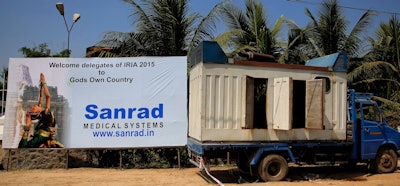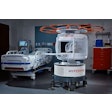
The evolution of medical imaging in India will be of interest to both the proponents and skeptics of free markets. Because most patients bear the full cost of imaging, prices and demand are not distorted by insurance coverage, which is still nascent.
Unsurprisingly, there is inequality. If there were a radiology version of the Gini coefficient, which measures the income inequality of a nation, India might top the score. Apollo Hospital in New Delhi, the Indian equivalent of the Cleveland Clinic, has a PET/MRI scanner. Meanwhile, there are villages without access to basic x-rays.
But the market for medical imaging in India is not bimodal, divided between the high end and the low end; rather, it is multisegmented and can be divided as follows:
- Private imaging centers
- Corporate and flagship hospitals
- Large academic centers
- Growth sector
The growth sector consists of smaller private hospitals, corporations that have bought imaging centers, government hospitals, and imaging centers in rural places that are funded solely by the state or through state partnership with the private sector. This is where the bulk of new purchases will be made in the next five years.
The first wave of adoption of imaging was by radiologists who owned their equipment. They broke the ice for MDCT, 64-detector-row CT, PET/CT, and 1.5- and 3-tesla magnets. This adoption was motivated by a desire to stay competitive.
Now, this segment is saturated. Demand has shifted from new toys for the sake of newness to technology that is adequate and is upgradable. There will be price sensitivity within a bandwidth. Stated differently, the vendor that provides "good enough" technology at a reasonable price will prevail.
 India is a country of contrasts, as evidenced by this scene near the conference center of the Indian Radiological and Imaging Association (IRIA) 2015 meeting. Photo by Dr. Woojin Kim.
India is a country of contrasts, as evidenced by this scene near the conference center of the Indian Radiological and Imaging Association (IRIA) 2015 meeting. Photo by Dr. Woojin Kim.CT
The CT segment most in demand, particularly in the growth sector, is the 16-detector-row scanner. Unless a center plans to offer coronary imaging, it will settle for 16-slice CT. This affirms that the great leap from 16-slice to 64-slice CT was motivated primarily by coronary imaging. CT coronary imaging in India is not induced by “rule-out acute coronary syndrome” in emergency departments. Cardiac CT substitutes catheter angiography for stable coronary artery disease.
The market for top-of-the-range CT scanners includes large corporate and flagship hospitals that leverage new technologies to assert their international brand and tap into the burgeoning medical tourism industry. For example, Apollo Hospital in Chennai has the 320-detector-row CT scanner from Toshiba Medical Systems. Sir H.N. Reliance Foundation Hospital in Mumbai, another hospital reliant on medical tourism, has the elite Somatom Force CT scanner from Siemens Healthcare.
As the screws on new technology are tightened in the U.S., hospitals in India will use that same technology to entice Americans (and others) to travel overseas for their healthcare. Apollo Hospital in Chennai has implemented proton-beam therapy. This technology has been under scrutiny in the U.S. because of its high cost and dubious benefit. Ironically, the poster child of waste in the U.S. is the poster child of high international standards in India.
Major academic centers such as the All India Institute of Medical Sciences and others funded by the central government will also make splashy rollouts of new high-end technology to establish their academic credentials and research potential.
With time, it's likely that 64-detector-row CT will disappear from the Indian market. Imaging centers interested in coronary imaging will opt for higher-end CT, if not top of the range. At the same time, 16-detector-row CT will be the workhorse and likely get cheaper as it penetrates further.
MRI
For MRI, 1.5-tesla systems are the magnets du jour. It's interesting that low-field magnets such as 0.2 tesla that were once cash cows in the U.S. never took off in India. One can only guess why. Perhaps MRI was never a cash cow in India. There's no Medicare, after all. If a cow can't be cashed, it might as well be a good-looking cow.
The demand for 3-tesla magnets is primarily motivated by neuroimaging. It's unlikely that 3 tesla will be the first choice in the growth sector. Large, well-established private imaging facilities might opt for 3 tesla to stay competitive. Nearly all major academic centers worth their reputation will have a 3-tesla magnet, as will flagship private hospitals that are looking at the international market.
PET/CT could diffuse quite rapidly in India. Those who own it use it, use it often, and use it well. As the Indian middle class grows wealthier in tier 3 cities -- those with populations of 20,000 to 49,999 -- citizens will demand more local services. They don't have to travel to New Delhi to eat KFC. They will demand reasonable oncological care locally as well. The first owner of PET/CT in such a city is likely to become rich. The 10th, maybe not.
PET/MRI will likely have the same fate as a stationary Segway. It will be known to a group of enthusiasts who have their own dinner parties and in jokes. I could be wrong, and it could take off; I'll happily eat dirt if it does.
Ultrasound
The real "coolie" of imaging in India, the faithful workhorse, is ultrasound. It has attained breadth and depth. Many radiologists offer advanced applications such as elastography and Doppler. However, ultrasound's growth has been tempered by the Indian Preconception and Prenatal Diagnostic Techniques Act, which bans fetal gender determination in order to prevent selective female feticide.
The regulations ground ultrasound: The machine must be registered to a radiologist or other qualified physician and to a precise geographical location of use.
This has all but stifled the market for portable ultrasound, such as use of the popular Visiq ultrasound scanner from Philips Healthcare. Instead, practices are coerced into purchasing bulkier machines such as the Affiniti 70, which is nearly seven times more expensive. The act has made it improbable that India will ever have a school for ultrasound technologists. All ultrasounds are performed by physicians.
The storm before the lull
Analyzing trends in imaging in India inevitably leads one to draw parallels with the U.S -- and there are many. This is all the more remarkable given the differences in the payment structures between the two countries.
In India, the growth of private medical imaging is slowing and approaching a plateau. One concern is that large corporations which have little to do with imaging are buying imaging centers. For example, in Delhi, Dabur has bought a number of imaging centers.
What is Dabur? It sells hair oil, skin, and beauty products. The company has turned its attention toward medical imaging because it sees profits. Profits are the prequel to commoditization; the storm before the lull. India is replaying imaging's familiar Greek tragedy. The story so far has unfolded predictably: physician ownership, profits, more profits, corporate ownership, even more profits, imaging chains (and commoditization).
Teleradiology is filling the gap of need. Presently, teleradiologists in India are not outbidding each other on price; they are soaking excess demand from small hospitals and hospitals in remote locations. They have plenty of work to do in the near future. There is time before they turn inward against each other and the rest of radiology in a price war.
That leaves hospitals. They are growing stronger and larger. They will entice the highest-end imaging and the best and brightest radiologists. They might be the last bastion against commoditization and Walmartization (or Daburization) of imaging. That radiology in India is facing the same eventuality as the U.S., where hospitals are getting stronger as well, without the Indian version of Obamacare, is strangely reassuring. Perhaps the hospital is the rightful abode of the radiologist.
Acknowledgments
The author would like to thank Dr. Nitin Ghonge, abdominal radiologist at Apollo Hospital, New Delhi, for his valuable insights.
Dr. Saurabh Jha is an academic radiologist who studies the value of imaging and believes in arguing for pedagogic benefits. He can be followed on Twitter @RogueRad.
The comments and observations expressed herein are those of the author and do not necessarily reflect the opinions of AuntMinnie.com.



.fFmgij6Hin.png?auto=compress%2Cformat&fit=crop&h=100&q=70&w=100)




.fFmgij6Hin.png?auto=compress%2Cformat&fit=crop&h=167&q=70&w=250)











